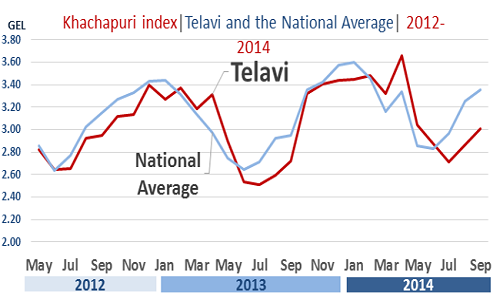- Details
The average cost of cooking one standard Imeretian khachapuri varied in September 2014 across Georgian cities from 3.01 GEL, the minimum observed in Telavi, to 3.55 GEL, the maximum observed in Tbilisi and Kutaisi. The average price was 3.35 GEL, which is 3.2% higher compared to the previous month (August 2014), and 13.7% higher compared to September of last year.
While most expensive in the average sense, Tbilisi offers the greatest savings for those “frugal housewives” who care to look for the cheapest ingredients. A frugal housewife would pay only 3.07 GEL for one portion of khachapuri in Tbilisi, saving a solid 13.7% of the average price. Telavi and Batumi are less friendly for frugal housewives, offering savings of 11.9 % and 8.2%, respectively. In the second largest Georgia city, Kutaisi, prices unexpectedly vary even less, and consumers should not expect any great bargains. Frugal housewives could not save about 5.2% of the average, paying about 3.37GEL for one portion of khachapuri.
- Details
In September 2014, the cost of cooking one Imeretian khachapuri gained 3.2% relative to August, reaching 3.35 GEL. Importantly, Khachapuri Index added much more 13.7% in annual terms, suggesting that Georgia is beginning to experience inflation, at least as far as food prices are concerned.
There is considerable variation in the level of Khachapuri Index across Georgias major cities. At 3.55 GEL, Tbilisi and Kutaisi currently top the list. Batumi is third at 3.30 GEL. Traditionally for this time of the year, Telavi lags far behind with 3.01 GEL (10 % below the national average).
- Details
The ISET Khachapuri Index continued moving along its upward seasonal trend, reaching 3.35 GEL in September 2014. This is 3.2% higher compared to August 2014 (m/m) and 13.7% higher compared to September 2013 (y/y). Such a sharp increase in prices was not unique to Khachapuri ingredients, however. As reported by GeoStat, the general Consumer Price Inflation (CPI) in September 2014 reached 1.2% in monthly terms and, what is more alarming, 4.8% relative to September of last year (y/y). At least to some extent, this may be caused by the extreme draught conditions in July and August, which decimated cereal, potato and vegetable harvests of smallholder farmers, and reduced the quality of pasture.













